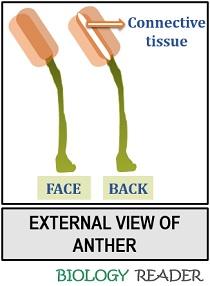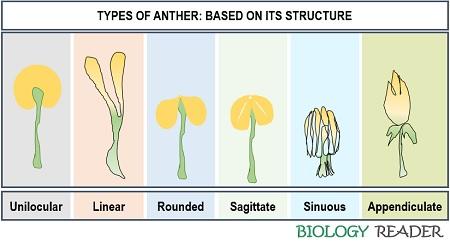The anther is a part of the flower’s male reproductive system or stamen. It carries the reproductive structures or the male gametes (pollen grains), which germinate and cause the fertilization of an ovule. A male reproductive part of a flower typically consists of two elements (filament and anther).
A filament appears as a long, slender and stalk-like structure found in the stamen. Anther has a bilobed structure that carry pollen grains in the pollen sacs. A filament of a stamen emerges out from the thalamus or peduncle and gives rise to a knob-like anther.
The number, length and position of a stamen can vary within the different range of flowers. In this context, we will discuss the definition, structure, types, functions and important events related to the anther.
Content: Anther
Definition of Anther
The anther is a structure found in the male reproductory part of the flower refers to as “Stamen” or “Androecium”. It has a knob-like structure, which usually consists of two lobes joined together by the connective tissue. It carry the pollen grains within the microsporangia, which further develops into a pollen sac.
The pollen grains released out during the process of dehiscence occurs after the process of Anthesis. The pollen grains are moved from the anther to the stigma of either the same or different flower during pollination. Thus, pollen transfer can occur via self or cross-pollination methods.
Structure
To understand the detailed structure of an anther, we must focus on its external and internal structure as well. Morphologically, an anther is a knob-like, bilobed, where the connective tissue connects both the lobe.
 But, if we look at the transverse section of an anther, we will come to know about many of its exciting features. As we could see in the diagram that the anther consists of two lobes and four chambers. The parenchymatous connective tissue separates the two lobes, and each lobe contains two thecae, which means an anther is dithecus. The external longitudinal groove or stromium separates the four chambers.
But, if we look at the transverse section of an anther, we will come to know about many of its exciting features. As we could see in the diagram that the anther consists of two lobes and four chambers. The parenchymatous connective tissue separates the two lobes, and each lobe contains two thecae, which means an anther is dithecus. The external longitudinal groove or stromium separates the four chambers.

The thecae or microsporangium consist of microspores. Due to the presence of four microsporangium, an anther is also called “Tetramicrosporangiate”. An epidermis forms the outer lining and protects the anther. On maturation, the microsporangium develops “Archaesporial cells”.
The archaesporial cells are the large, individual cells with dense cytoplasm that remain hypodermal in condition. Then, the archaesporial cells undergo “Periclinal division”. A periclinal division is a kind of transverse division that divides the cells into:
- Peripheral primary parietal cells
- Inner primary sporogenous cells
Parietal cells protect the inner sporogenous cells and further undergo some periclinal and anticlinal divisions to form three differentiated layers of cell:

- Outer endothecium: Parietal cell first undergoes mitosis and differentiates into outer endothecium, which functions at the time of dehiscence. It is a monolayer of flattened cells.
- Middle layer: Parietal cell further divides and differentiates to form a middle layer. An intermediate layer usually comprises 1-3 layers of the parenchymatous cells.
- Inner tapetum: Outer endothecium and middle layer constitute the third layer (Tapetum). It comprises pyramid-shaped cells that exhibit a radial arrangement around the microsporangium. Tapetum serves as a nutritive layer, which provides nourishment to the growing sporogenous cells.
Video
Anther Types
It is classified into many kinds, based on its structure and attachment with the filament.
Based on Structure

- Bilobed: It is the most common type that consists of a bilobed structure, which occurs in all mature stamens of the angiosperms.
- Unilocular: It consists of a single lobe like the members of the Malvaceae family. The unilocular condition arises due to:
- Destruction of one lobe.
- Destruction in the connective tissue that holds the two lobes.
- And by the destruction of longitudinal grooves that separates the microsporangia.
- Linear: This occurs in the genus Acalypha.
- Rounded: It appears in the genus Merculiaris.
- Sagittate: It is common in the genus Vinca.
- Sinuous: It has a peculiar filamentous type appearance and occurs in the members of Cucurbitaceae.
- Reniform: China rose consists of a reniform anther.
- Appendiculate: It appears in the Erica cinerea of Ericaceae.
Based on Attachment to the Filament

- Adnate: In this type, an anther is present in continuation with the filament, as in Magnolia and water lily.
- Innate: Here, a filament is attached to the basal region of an anther, like in mustard plants. It also refers to basifixed-anther.
- Dorsifixed: In this type, a filament attaches to the dorsal side or back of an anther, like in Sesbania.
- Versatile: Here, an anther is attached to the middle of a filament and swings freely, like in grasses.
Functions
The functional role of an anther can be understood by knowing the distinct role of the individual components:
- The epidermis forms the lining of an anther that acts as a “Protective sheath” by providing structural integrity and strength. Epidermis also plays an essential role in the process of gaseous exchange between an anther and surrounding. It protects internal cells against dehydration and extreme conditions.
- Endothecium is the second layer that facilitates the anther dehiscence and provides structural support to the internal structures.
- The middle layer is the third layer beneath the large endothecium cells, which serve to store starch. The starch mobilizes to the pollen grains during the maturation.
- Tapetum is the fourth and last layer that radially surrounds the microsporangium. Tapetum is a nutrient-rich layer that provides nourishment to the pollen grains during their development. It consists of auxin hormone and callose enzyme, promotes the growth of pollen grain. Tapetum forms a compatible protein, which means the pollen grains that are compatible with the female gametophyte will only germinate.
Important Events
Anthesis: It refers to the process during which the anthers dangle out from the spikelet of the growing flower. The process of dehiscence occurs during the stage of anthesis when a flower attains maturity.
Dehiscence: On maturation, the anther burst out by discharging pollen grains. Thus, pollen release from an anther is a process that refers to the “Dehiscence”. Based on the direction of dehiscence, anther releases pollen grains in the following ways:

- Transverse dehiscence: In this, pollen releases away from the centre of the unilocular anther.
Example: Members of the Malvaceae family. - Longitudinal dehiscence: Here, the pollen releases laterally or longitudinally, neither towards nor away from the axis.
Example: Datura - Poricidal dehiscence: In this type, pollen releases from the apical or distal region.
Example: Potato, Brinjal etc. - Valvular dehiscence: In this type, pollens release through valves or trap doors.
Example: Berberries, Laurus etc.
Pollination: It is also involved in the process of pollination, where the pollen grains released due to dehiscence are captured by the stigma via pollinators.
Thus, an anther plays a crucial role in flower fertilization and development.
Is the archesprial cell mature form of microsporangiun?
On the maturation, microsporangia develop archeasporial cells.
Thank you!
Thanks!